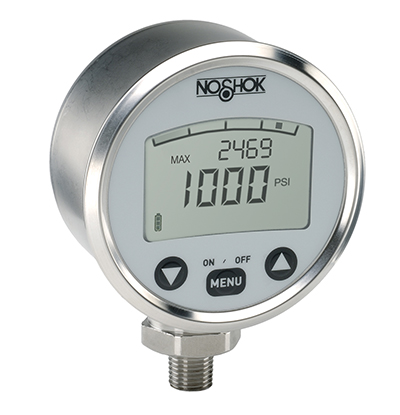By Josh Cosford, Contributing Editor
If you just want to observe pressure for the lowest cost possible, you can go down to your tractor supply store and buy a ¼-in. bottom mount pressure gauge for the price of a burger combo meal. But all you get is a way to observe pressure. Yes, a pressure gauge is accurate and reliable (maybe not the burger combo equivalent, however), but sometimes you ask for more of your pressure monitoring device.

The rugged 1000 series digital electronic gauge from Noshok is rated for compound and standard ranges from 0 to 10,000 psi.
First off, there isn’t much precision in staring at a sometimes-vibrating needle with delineations every 1,000 psi. However, an excellent digital pressure gauge offers accuracy down to 0.025%, and even if that accuracy provides no value in the average application, other applications take advantage of this accuracy. Accurate observation of suction or case pressure, in some cases, may help when you can measure and observe with precision. Even a terrible quality digital gauge with 0.5% accuracy offers plenty of confidence that what you see in a glance is what the pressure is.
Although analog gauges may come available with sliding indicators that mark the desired minimum or maximum pressure, you must still watch the gauge when such pressure extremes occur. However, digital pressure gauges may use data logging to save the minimum and maximum value and then reset them easily to restart a cycle.
I’m sure you’ve been in many dark corners of a plant where little light shone on the pressure gauge, requiring a flashlight or mobile phone to read accurately. Digital pressure gauges come equipped with backlights, and a press of a button will light up the LCD screen to make readings effortless.
As you’d expect, technology has permeated further than a backlit digital display. Better than a backlit display is a wireless transceiver that sends readings to your PC. Data at your PC offers the advantage of evaluation and analysis through spreadsheets and charts, making them a valuable predictive maintenance tool.
Because analog gauges use markings printed on their face, you’re limited to the units on any given gauge, and if you’re lucky, you’ll get dual units such as psi and bar. On the other hand, a digital gauge may offer as many unit options as are in common use, such as psi, bar, MPa, or even kg/m², depending on your geographic market.
If you weren’t convinced that a digital gauge offers much more than a pressure reading, the more optioned units come available with switching outputs. With so many benefits, it’s easy to see why the digital gauge has become so popular. Although quite a bit more expensive than analog gauges, they continue to drop in price just like all electronics.
Filed Under: Engineering Basics, Sensors & Gauges